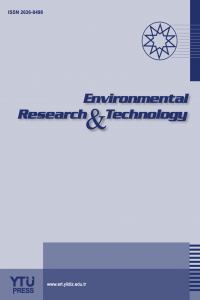Synthesis of Fe3O4/Humic Acid/Silver nanoparticles and their application in Cu and Cd adsorption
Synthesis of Fe3O4/Humic Acid/Silver nanoparticles and their application in Cu and Cd adsorption
___
- [1] Faraji M, Yamini Y, Razaee M (2010) Magnetic nanoparticles: Synthesis, Stabilization, Functionalization, Characterization and its applications. J. Iran. Chem. Soc. 7(1):1. doi: 10.1007/BF03245856
- [2] W. Z. Zhang, “Nanoscale iron particles for environmental remediation: An overview,” J. Nanopart Res., vol. 5, pp323-332, 2003.
- [3] Y. C. Chang, D. H. Chen, “Preparation and adsorption properties of monodisperse chitosan-bound Fe3O4 magnetic nanoparticles for removal of Cu(II) ions,” J. Colloid Interface Sci., vol 283, pp446-451, 2005.
- [4] N. Savage, M. S. Diallo , “Nanomaterials and water purification: oppurtunities and challenges,” J. Nanopart. Res., vol 7, pp331-342, 2005.
- [5] E. Erdem , N. Karapınar, R. Donat, “The removal of heavy metal cations by natural zeolites,” J. Colloid and Interface Sci. , vol 280, pp 309-314, 2004.
- [6] Y. G. Ko, U. S. Choi, “Diverse applications of fibers surface-functionalized with nano- and microparticles,” Composites Science and Technology, vol 79, pp 77-86, 2013.
- [7] K. Aguilar-Artega, J. A. Rodriguez, E. Barroda, “Magnetic solids in analytical chemistry: A review.”, Analytica Chimica Acta., vol. 674, pp 157-165, 2010.
- [8] B. H. Jun, M. S. Noh, G. Kim, H. Kang, J. H. Kim, W. J. Chung, M. S. Kim, Y. K. Kim, M. H. Cho, D. H. Jeong, Y. S. Lee, “Protein separation and identification using magnetic beads encoded with surface enhanced Raman spectroscopy,”Anal. Biochem., vol. 391, pp. 24-30, 2009.
- [9] S. Yean, L. Cong, J. T. Yavuz, M. Yu, “Effect of Material Particle Size on Adsorption and Desorption of Arsenite and Arsenate”, J. Mat. Res., vol. 20, pp. 3255-3264, 2005.
- [10] M. Rong, M. Q. Zhang, H. Liu, H. Zeng, “Synthesis of silver nanoparticles and their self-organization behavior in epoxy resin,” Polymer , vol. 40, pp. 6169-6177, 1999.
- [11] M. Z. Rong, M. Q. Zhang, H. B. Wang, H. M. Zeng, “Surface modification of magnetic metal nanoparticles through irradiation graft polymerization,” Applied surface science, vol. 200, pp. 76-93, 2002.
- [12] S. T. Dubas, V. Pimpan, “Humic acid assisted synthesis of silver nanoparticles and its application on herbicide detection,” Materials Letters , vol. 62, pp. 2661-2663, 2008.
- [13] E. Pena-Mendez, J. Havel, J. Patocka (2004), “Humic substances- compounds of still unknown structure: applications in agriculture, industry, environment and biomedicine,” J. Appl. Biomed., vol. 3, pp. 13-24, 2004.
- [14] E. A. Ghabbour, G. Davies, N. K. Ghali, M. D. Mulligan, “The effect of temperature on tight metal binding by peat and soil derived solid humic acids,” Canad. J. Soil. Sci., vol. 81, pp. 331-336, 2001.
- [15] J. B. Green, S. E. Manahan, “Absorption of sulphur dioxide by sodium humates,” Fuel , vol. 60, pp. 488-494, 1981.
- [16] A. Oehmen, Z. Yuan, L. L. Blackall, J. Keller, “Short-term effects of carbon source on the competition of polyphosphate accumulating organisms and glycogen accumulating organisms,” Water Sci. Technol. , vol 50, pp.139-146.
- [17] E. lls, E. Tombacz, “The role of variable surface charge and surface complexation in the adsorption of humic acid on magnetite,” Colloids Surf. , v. 230, pp. 99-109, 2003.
- [18] J. F. Liu, Z. S. Zhao, G. B. Jiang, “Coating Fe3O4 magnetic nanoparticles with Humic acid for high efficient removal of heavy metals in water,” Environ. Sci. Technol., vol. 42, pp. 6949-6954, 2008.
- [19] B. Lv, Y. Xu, H. Tian, D. Wu, Y. Sun, “Synthesis of Fe3O4/ SiO2/Ag nanoparticles and its application on surface enhanced Raman scattering,” Journal of solid state chemistry , v.18, pp. 2968-2973.
- [20] N. Unlu, M. Ersoz, “Adsorption characteristics of heavy metal ions onto a low cost biopolymeric sorbent from aqueous solutions,” J. Hazard Mater., vol. 136, pp. 272-280, 2006.
- Yayın Aralığı: Yılda 4 Sayı
- Başlangıç: 2018
- Yayıncı: Yıldız Teknik Üniversitesi
Assessment of noise pollution due to generators in Akure
Francis Olawale ABULUDE, Samuel Dare FAGBAYİDE, Smart A OLUBAYODE, Ebenezer Alaba ADEOYA
Synthesis of Fe3O4/Humic Acid/Silver nanoparticles and their application in Cu and Cd adsorption
Fatos Ayca OZDEMİR OLGUN, Gozde Mediha KAMER, Birsen DEMİRATA OZTURK
